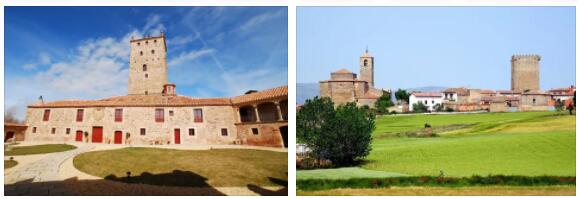
The small provincial capital of Soria is located on the banks of the Duero River in northern Spain. The province of Soria is part of the autonomous region of Castile-Leon.
Before our era, the Celtiberian tribes lived here. In the 3rd century BC. in the vicinity of modern Soria, the Celtiberian settlement of Numantia was founded, which was captured by the Romans in the 2nd century BC. The inhabitants of the city put up heroic resistance to the Roman troops, which made them famous for centuries. In the Middle Ages, Soria was one of the most important centers of wool production. Today, Soria is a small provincial town.
According to Cancermatters, the main attractions are located in the Old Town, the center of which is the Plaza Mayor. The square is surrounded by Romanesque buildings. Here you can also see the Church of Santa Maria la Mayor with an interesting Romanesque facade. Nearby is the 12th century Santo Domingo Church, one of the most beautiful churches in the city. Of greatest interest is its facade, crowned with an arch with sculptural compositions. It is worth visiting the Cathedral of San Pedro (12th century), which was rebuilt in the 16th century in the Renaissance style. The facade of the cathedral, made in the plateresco style, and the internal gallery of the 12th century, supported by columns decorated with ornaments, are very beautiful. Also in Soriainteresting Romanesque church of San Juan de Rabanera (12th century) – one of the earliest buildings in the city; the 16th century Condes-Gomar palace (now the Palace of Justice); the monastery of San Juan de Duero, which until the 18th century belonged to the Order of the Hospitallers; and the church of San Saturio, located on a rock above the Duero River, where the relics of the city’s patron saint, Saturios, are kept.
Especially popular is the Numanti Museum, which tells about the history of the region from the Paleolithic era to the present day. Archaeological finds are presented here, ranging from mammoth bones to ceramics of the Celtiberian tribes. Most of the exhibits were found at the excavations of the nearby destroyed Celtiberian settlement of Numantia.
The ruins of the Numantia settlement are located 8 km north of Soria. It was founded by the Celtiberian tribes in the 3rd century BC. In the 2nd century BC. The Romans tried to capture Numantia for 20 years, however, its inhabitants put up fierce resistance to the Roman troops. After an 11-month siege of the city, the inhabitants, realizing that the city could not be saved, set fire to it and began to kill each other. The Romans entered the already devastated city. Numantia was rebuilt under the Romans. The ruins of Numantia were discovered in the 19th century and are now one of the most popular archaeological sites in Spain. Every year on the last Saturday of July, reconstruction battles of the Numantines and Romans are held here. Burgo de Osma is interesting
55 km southwest of Soria. (Burgo de Osma). Under the Visigoths, starting from the 6th century and ending with the Arab conquest of these lands, the residence of the bishop was located in Burgo de Osma. The main attraction of the city is the Gothic Cathedral of the 12th century, inside which many art objects of the Romanesque era have been preserved. Also notable are the Bishop’s Palace, the remains of the 15th century ramparts, the Renaissance building of the University of Santa Catalina from the 16th century, the castle from the 8th century and the Roman bridge.
In the vicinity of Soria, it is also worth visiting such ancient towns and villages as Calatanazor with the ruins of an Arab fortress; Almasan (Almazan) with churches of the 12th century and the remains of fortress walls and gates; Medinaceli(Medinaceli) with a 1st century Roman triumphal arch; and San Esteban de Gormaz, where the remains of a fortress and two Romanesque churches from the 11th and 12th centuries have been preserved.
In the western part of the province, 60 km from Soria, the Canyon del Rio Lobos nature reserve is located. Over many millennia, the flow of the Lobos River has formed a canyon with sheer walls, surrounded by pine and juniper forests. One of the main attractions of the canyon are its birds of prey: eagle owls, vultures, griffon vultures, falcons and golden eagles. There are also several caves in the park.
In the northwest of the province of Soria along its border with the provinces of Burgos and La Rioja stretches the Sierra de Urbion mountain range, which is part of the Iberian mountain range. The maximum mark is Mount Pico-Urbion (2228 m). Dense forests and glacial lakes are found among the mountainous landscapes of the region. This is a great place for hiking. The main settlement of these places is the village of Vinuesa. From here you can travel to the glacial lakes of Laguna Negra and Laguna de Urbion, surrounded by sheer cliffs, and to Mount Pico Urbion. Nearby is the Cuerda del Pozo reservoir, where in the summer you can enjoy a variety of water sports or simply sunbathe and swim. Santa Ines ski station is located 10 km north of Vinues in the mountains at an altitude of 1753 m .